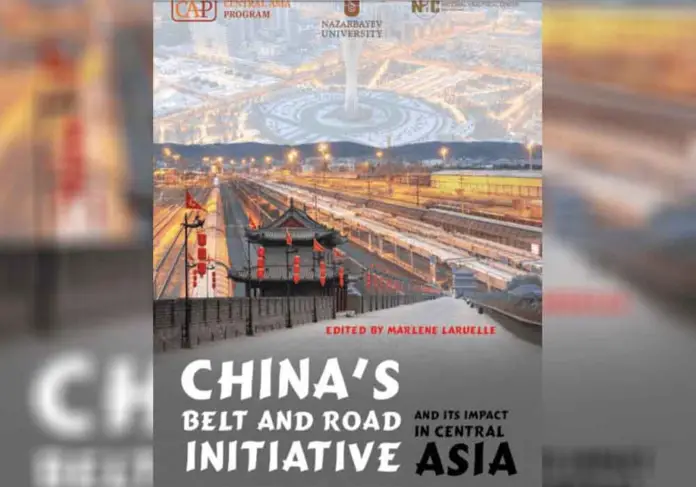The central theme of the highly insightful book – China’s Belt and Road Initiative and Its Impact in Central Asia – covers the most significant phenomenon of modern day geo-economics. As the name suggests, the book is precisely focused on China’s landmark Belt and Road Initiative and the analysis of its prospects and challenges for Central Asian Republics. This book was published concurrently after the launch of the Belt and Road Initiative by China in 2013.
This scholarship combines multidisciplinary methodological and theoretical approaches such as political sciences, security, sociology and economics. The three main parts of book are divided in fifteen chapters providing micro and macro level of comprehensive insight into BRI, including but not limited to its objectives, nature and range of projects, financial model, investment volume and elements of soft power.
Chinese President Xi Jinping announced BRI in 2013 at Nazarbayev University, Kazakhstan with intentions to project China as a leader of Asia in all spheres of statecraft including politics, economy, security, culture and commerce. The analysis is characterized by the deep understanding of China’s Belt and Road Initiative: the aims, challenges and its impact on Central Asia.
In part, this book presents the Chinese goal to incorporate all ongoing infrastructure projects in Central Asia in to the framework of BRI along with the offering of multiple new development initiatives. This reflects a shift in Chinese policy of low cost model ‘made in China’ into value-added model known as ‘created by China’. Although the author is skeptical about the fate and pace of the implementation on projects, but agrees that BRI is a promising initiative to benefit all the participant nations. She poses a valid question asking why China is generous to unleash its economic resources to other states and introspect the objectives of China. The answers she provides reflect true Chinese intentions which include One China Policy, eradication of three evils through RATS (Regional Anti-Terrorist Structure) of Shanghai Cooperation Council, support in international organizations like the UN, delinking from Uyghurs and non-recognition of Taiwan.
The book offers a retrospect on improving cross border trade by information exchange, customs clearance, cooperation in inspection and removal of investment and trade barriers. Chinese investment into Central Asia is about creating markets to stimulate trade with three bordering Central Asian states; Kazakhstan, Kyrgyzstan and Tajikistan with Xinjiang. Connectivity through physical infrastructure and investment also seek to preserve the political status quo. The author clearly identifies that the economic development in Xinjiang does not address Uyghurs’ concerns and that cultural discrimination will continue.
Kazakhstan, Kyrgyzstan and Tajikistan have taken several steps to harmonize policies with China. China and Kazakhstan are spending US $26 billion, including in mining, smelting, engineering, chemicals and petro-chemicals. Tajikistan, which is capable of storing large amounts of water, increases its influence in relation to Uzbekistan. In Tajikistan, Chinese investment in agriculture sector is commercial rather than political. Tajikistan and Kyrgyzstan are significant for the liquid gold resources. Tajikistan is rich in 50 types of natural resources and over 600 deposits are discovered during the last decades.
Marlene draws attention towards the four economic areas: 1) driving internationalization of construction industry, 2) encouraging exports, 3) reducing risks in supply chain, 4) investments in interior of the country. Marlene is under no illusion about the assuring that investment reaches local government through Special Economic Zones (SEZ). As connectivity is the buzz word for BRI, BRI is not only concerned about connectivity but also developing a narrative of the government to allay the fears of the international community. Chinese government is also cautious about terrorism. In December 2015, China developed anti-terrorism law and People’s Liberation Army (PLA) is responsible for defending China’s interests and combating terrorism abroad. In context of Pakistan, CPEC is the game changer as Gwadar is linked with eastern and western China. CPEC also solves the Chinese issue of Malacca Dilemma as the route between Gwadar and Xinjiang is just 3000 km.
The writer is inflexible about the foreign aid based on grants, free loans and concessional loans as it will create dependency. Terms like rogue donors, irresponsible power, spectacular state, warm political state, cold public state, harmonious neighbors and predatory lender are used for China. In the urge of job creations and wages, Chinese government is failing to meet the expectations of locals. According to the National Strategy of Innovative Industrial Development (NSIID), focus is on seven sectors: 1) food processing, 2) textile manufacture, 3) transportation logistics, 4) tourism, 5) metallurgy, 6) construction materials and 7) oil and gas machine building. Investments have been made in six areas: 1) transportation and logistics, 2) industrial infrastructure, 3) energy, 4) water and heat supply networks, 5) strengthening of housing infrastructure and 6) social infrastructure.
BRI gives each country its own comparative advantages and win-win situation. Provision of external stimulus for Chinese companies, expansion of geopolitical influence and provision of resource security are the three main core purposes of BRI. The Chinese government under the umbrella of BRI, divided infrastructure projects into two types: reactive and proactive. Here, the author highlights a few good aspects of BRI, which are that it focuses on nation’s civilization, emphasizes equality to solve border disputes and does not interfere in the internal affairs of the countries. The writer also highlights the lack of border management and poor regional and interregional cross border trade issues.
There are few aspects that remained unaddressed. On the broader level, there exist few risk factors: Will China become a leading economy of the world? What will happen as a result of the evolvement of a domestic situation in the future? How will China tackle the challenge for central planners with aging population? How will China cater the bad governance issues of the Central Asian states? What are the policies of engaging political risks that may jeopardize the reputation of BRI? How rent-seeking behavior is only restricted to legal and semi-legal activities? What are the anti-corruption laws? Why China is not held accountable for indirectly contributing to social unrest and violent manifestations? Why informal trade barriers are not considered important? It is aimed that new engines of cooperation between China and Central Asian countries are needed to make BRI more impactful. With no doubt, BRI is an element of China’s Dream which involves establishing supremacy in Asia.







